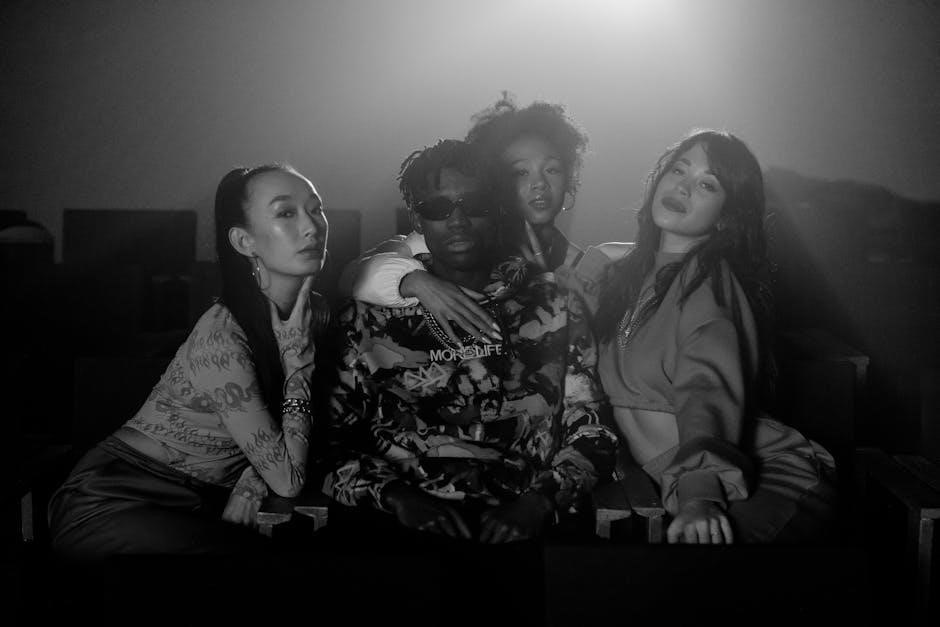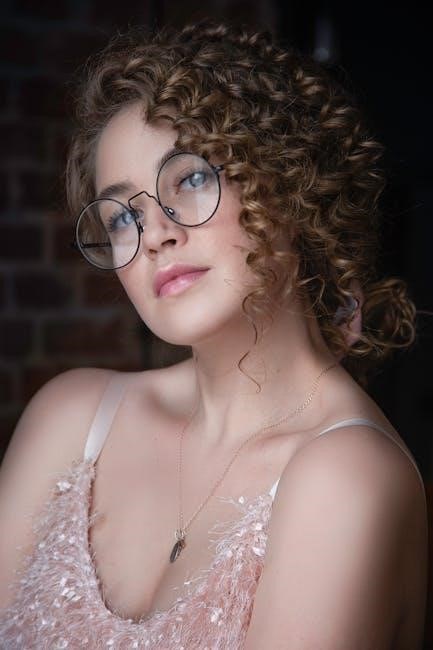Diffusion models are powerful generative models that have revolutionized imaging and vision tasks by learning to gradually denoise data, enabling high-quality image synthesis and manipulation.
1.1 Overview of Diffusion Models
Diffusion models are a class of generative models that operate by gradually adding noise to data and then learning to reverse this process. They have emerged as a powerful tool in imaging and vision, offering versatile solutions for tasks like image synthesis, restoration, and manipulation. By iteratively denoising data, these models capture complex distributions, enabling high-quality generation. Their unique approach to learning makes them particularly effective for tasks requiring fine-grained control, such as text-to-image generation and super-resolution imaging. This overview provides a foundational understanding of diffusion models, setting the stage for deeper exploration of their mechanisms and applications.
1.2 Importance in Imaging and Vision
Diffusion models have become indispensable in imaging and vision due to their ability to generate and manipulate high-quality visual content. They excel in tasks like image synthesis, inpainting, and super-resolution, producing results that often surpass traditional methods. Their importance lies in their versatility and the realistic outcomes they achieve, making them a cornerstone for applications in computer vision and creative industries. By leveraging their denoising capabilities, diffusion models address challenges in restoring degraded images and generating diverse visual scenarios, solidifying their role as a transformative technology in modern imaging and vision systems.

Theoretical Foundations
Diffusion models are rooted in a probabilistic framework, involving forward and reverse processes that gradually add and remove noise, enabling versatile applications in imaging and vision tasks.
2.1 Forward Process and Reverse Process
The forward process gradually adds noise to data, transforming it into a random distribution, while the reverse process learns to denoise, reconstructing the original data distribution. This dual mechanism is central to diffusion models’ generative capabilities, enabling them to produce high-quality images and perform complex vision tasks effectively. By understanding these processes, developers can harness the power of diffusion models for various applications in imaging and computer vision.
2.2 Loss Functions and Training Objectives
Diffusion models utilize a loss function that trains the model to predict the noise added during the forward process. The primary objective is to minimize the difference between the predicted and actual noise, enabling the model to learn the reverse process effectively. This training strategy ensures the model can reconstruct data by gradually denoising it, which is essential for generating high-quality images. The loss function operates at each timestep of the diffusion process, guiding the model to recover the original data distribution accurately.
2.3 Role of Noise in Diffusion Models
Noise plays a central role in diffusion models, as it is gradually added to data during the forward process and removed during the reverse process. The model learns to predict the noise at each timestep, enabling it to reconstruct the original data distribution. This process begins with adding random noise to the input data, creating a corrupted version. The model then learns to reverse this corruption by iteratively denoising the data. The careful balancing of noise addition and removal is crucial for training, as it allows the model to capture complex data distributions and generate high-quality outputs. The variance schedule for noise addition is key to model stability.

Conditional Diffusion Models
Conditional diffusion models extend base diffusion models by incorporating additional data, like text, to guide generation. They enable targeted outputs, such as text-to-image synthesis, enhancing creativity and control.
3.1 What Are Conditional Models?
Conditional diffusion models are extensions of base diffusion models that incorporate additional information, such as text or class labels, to guide the generation process. They differ from unconditional models by focusing on specific outputs rather than general data distributions. By conditioning on external inputs, these models enable targeted generation, such as creating images that match a given description. This makes them highly versatile for tasks like text-to-image synthesis, where the model generates visuals based on textual prompts. Conditional models achieve this by modifying the forward or reverse processes to account for the provided context, enhancing both control and creativity in imaging and vision applications.
3.2 Applications in Text-to-Image Generation
Conditional diffusion models have become pivotal in text-to-image generation, enabling the creation of high-quality visuals from textual descriptions. By leveraging the guidance of text prompts during the denoising process, these models produce images that align closely with the input text. This capability has applications in creative design, where artists can generate concept art or visualize ideas. Additionally, text-to-image models facilitate tasks like advertising, where specific product visuals can be generated based on descriptions. The integration of vision-language models further enhances these applications, allowing for more precise and context-aware image generation, thereby expanding the potential of AI in artistic and commercial domains.
Training Techniques
Training diffusion models involves optimizing denoising processes, leveraging methods like DDPM and DDIM. Techniques include noise scheduling, conditional guidance, and fine-tuning for specific vision tasks efficiently.
4.1 Overview of Training Methods
Training diffusion models involves optimizing the denoising process through iterative refinement. The framework typically includes a forward process that gradually adds noise and a reverse process that learns to remove it. Key objectives are minimizing the loss function, often using variants like DDPM or DDIM, which differ in their approach to noise prediction or removal. Conditional models further incorporate guidance signals to direct synthesis. Training strategies include noise scheduling, learning rate optimization, and leveraging datasets specific to vision tasks. These methods ensure models generate high-quality, context-aware images effectively.
4.2 Denoising Diffusion Implicit Models (DDIM)
DDIM is an efficient variant of diffusion models that achieves faster sampling by leveraging non-Markovian steps. Unlike traditional diffusion models, DDIM priming employs a low-noise signal and refines it iteratively, enhancing quality. This approach reduces the need for Markov chains during sampling, making it computationally efficient. DDIM excels in tasks like image synthesis, inpainting, and super-resolution, offering high-quality results with fewer steps. Its efficiency and effectiveness make it a popular choice for practical applications in imaging and vision, particularly where generation speed and resource utilization are critical factors.
4.3 Denoising Diffusion Probabilistic Models (DDPM)
DDPMs are foundational to diffusion models, establishing the framework for both forward and reverse processes. They involve gradually adding Gaussian noise to data and training a model to reverse this noising process. Unlike DDIM, DDPMs rely on Markov chains for sampling, offering precise control over the denoising steps. This probabilistic approach ensures high-quality generation but at the cost of slower sampling times. DDPMs are widely used in imaging tasks, including synthesis and restoration, due to their stability and ability to produce realistic outputs, making them a cornerstone of modern generative methodologies in vision and imaging applications.

Applications in Imaging and Vision
Diffusion models have transformative applications in imaging and vision, excelling in image generation, inpainting, restoration, and super-resolution, while advancing Vision-Language Models for enhanced visual understanding.
5.1 Image Generation and Synthesis
Diffusion models have emerged as powerful tools for image generation and synthesis, enabling the creation of high-quality, realistic, and diverse visuals. By learning to gradually add and remove noise, these models can synthesize complex images from random noise distributions. Their ability to model detailed textures and patterns makes them particularly effective for generating photorealistic images. Applications range from artistic designs to realistic image synthesis, offering unparalleled flexibility in generating custom visuals. The models’ iterative denoising process allows for precise control over the final output, making them highly versatile for both creative and practical imaging tasks.
5.2 Image Inpainting and Restoration
Diffusion models excel in image inpainting and restoration, effectively addressing missing or corrupted image regions. By leveraging their denoising capabilities, these models can fill gaps and restore damaged areas seamlessly. The iterative process allows the model to learn the context and semantics of the image, ensuring coherent and realistic reconstructions. Whether repairing old photographs or removing unwanted objects, diffusion models provide high-quality results. Their ability to handle various types of corruption makes them invaluable for restoring degraded images while preserving original details, offering a powerful solution for enhancing and preserving visual content.
5.3 Super-Resolution Imaging
Diffusion models have emerged as a powerful tool for super-resolution imaging, enabling the generation of high-resolution images from low-resolution inputs. By leveraging the iterative denoising process, these models learn to enhance image details effectively. Unlike traditional interpolation methods, diffusion-based approaches can produce sharper and more realistic results by capturing complex contextual information. This technique is particularly valuable in applications like medical imaging, where fine details are critical, and surveillance, where image clarity is essential. The ability to upscale images while maintaining quality makes diffusion models a promising solution for enhancing visual data across various domains.
5.4 Vision-Language Models (VLMs)
Vision-language models (VLMs) integrate visual and textual data, enabling tasks like text-to-image generation and image captioning. Diffusion models enhance VLMs by generating high-quality images from text prompts through iterative denoising. Transformers are often used to process multimodal inputs, aligning visual and linguistic features. This synergy allows VLMs to understand complex contexts, producing realistic and contextually relevant images. Applications include creative design, advertising, and multimedia content creation, making VLMs a transformative tool in imaging and vision, bridging the gap between human language and visual representation effectively.

Future Directions and Challenges
Future directions include improving efficiency, scalability, and multimodal integration. Challenges involve addressing mode collapse, training complexity, and ethical considerations for responsible AI deployment and use.
6.1 Emerging Trends in Diffusion Models
Emerging trends in diffusion models include advancements in Vision-Language Models (VLMs), enabling multimodal generation and enhanced text-to-image synthesis. Researchers are also exploring efficient architectures, such as prompt-free diffusion, to simplify workflows. Additionally, the integration of diffusion models with generalist approaches, like InstructCV, is expanding their applicability across diverse computer vision tasks. These innovations are pushing the boundaries of generative capabilities, offering more versatile and user-friendly tools for imaging and vision applications while maintaining high-quality outputs and addressing real-world challenges effectively.
6.2 Challenges and Limitations
Despite their success, diffusion models face challenges such as complex training processes and high computational demands. They often struggle with generating coherent images in scenarios involving multiple objects or intricate contexts. Additionally, models can exhibit unexpected failures in basic tasks, highlighting limitations in generalization. The need for large datasets and extensive training time remains a barrier. Furthermore, Vision-Language Models (VLMs) sometimes require multiple images for tasks like script generation, which can complicate real-world applications. Addressing these challenges requires advancements in model architecture, training efficiency, and evaluation metrics to enhance robustness and scalability for diverse imaging and vision tasks.
